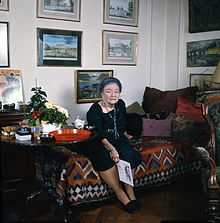Moura Budberg

Maria Ignatievna Budberg (Russian: Мария (Мура) Игнатьевна Закревская-Бенкендорф-Будберг, Maria (Moura) Ignatievna Zakrevskaya-Benckendorff-Budberg), also known variously as Countess Benckendorff, Baroness Budberg (c. 1891 – November 1974), born in Poltava, was the daughter of Ignaty Platonovitch Zakrevsky (1841–1905), a Russian nobleman and diplomat. She was an adventuress and double agent of OGPU and British Intelligence Service.[1]
She first married Johann von Benckendorff, a high-ranking Czarist diplomat, in 1911. They owned the mansion called Jendel in Jäneda, in Estonia where he was shot dead in 1918 by a local peasant. Before the October Revolution Moura worked in the Russian Embassy in Berlin where she became acquainted with British diplomat R. H. Bruce Lockhart. Upon the assassination of her husband in 1918, she was arrested in a suspicion of spying for England and transferred to the Lubyanka prison. Bruce Lockhart, who mentions her, under her given name, in his book Memoirs of a Secret Agent[2] tried to vouch for her, however he was detained as well for couple of weeks. Some[3][4] allege that they were lovers.
After Lockhart was released and expelled from Russia soon after, in connection with the "Ambassadorial Conspiracy" affair (also known as the "Lockhart conspiracy"). Budberg was released as well under the condition that she would cooperate with the intelligence service if the need should arise in the future. Budberg got a job publishing "World Literature", where she met the writer Maxim Gorky with the help of Korney Chukovsky. She became a secretary and common law wife of Gorky, living in Gorky's house with a few interruptions from 1920 to 1933 (when the writer lived in Italy before returning to the USSR). He bitterly dedicated to her his last major work, the novel "The Life of Klim Samgin".
In 1920 she met historian and science fiction writer H. G. Wells[5] and became his mistress. Their relationship was renewed in 1933 in London, where she emigrated after parting with Gorky. A close relationship with Wells continued until his death; Wells asked her to marry him, but Budberg strongly rejected this proposal.
She visited the Soviet Union twice, in 1936 for the funeral of Gorky (which made people call her an agent of the NKVD) and at the end of 1950, with her daughter Guchkov.
Later, she was briefly married to Baron Nikolai von Budberg-Bönningshausen.
She was widely suspected of being a double agent for both the Soviet Union and British intelligence and has been called the "Mata Hari of Russia", after the famous Dutch exotic dancer and accused spy.
Among her many activities, she wrote books and was the script writer for at least two films: Three Sisters directed by Laurence Olivier and John Sichel (1970), and The Sea Gull directed by Sidney Lumet (1968).[6][7]
An MI5 informant said of her, "she can drink an amazing quantity, mostly gin".[8]
Moura Budberg's older half-sister, Alexandra 'Alla' Ignatievna Zakrevskaya (1884–1960), who married Baron Arthur von Engelhardt before 1909, was the great-grandmother of Nick Clegg, leader of the British Liberal Democratic Party since December 2007, and Deputy Prime Minister of the United Kingdom from May 2010.
Legacy
In May 2008 a television film "My Secret Agent Auntie" directed by Dimitri Collingridge was released in England.[9]
External links
- Berberova, Nina (June 2005). Moura: The Dangerous Life of the Baroness Budberg. New York Review Books Classics. ISBN 1-59017-137-3.
- Sander, Gordon. "Estonia Lost and Found: Moura Budberg, H.G. Wells, and the Lost World of Yendel (Estonian Air 1/05)". Retrieved 2009-10-22.
- Tweedie, Neil; Day, Peter (November 2002). "Baroness warned MI5 about Blunt in 1951". London Telegraph. Retrieved 2006-10-23.
- Budberg, Moura; Williams-Ellis, Amabel (August 1991). Russian Fairy Tales (Audio Cassette). HarperCollins Canada / Hus Kids Audio. ISBN 1-55994-399-8.
- The Murder of Maxim Gorky. A Secret Execution by Arkady Vaksberg. (Enigma Books: New York, 2007. ISBN 978-1-929631-62-9.)
- Translated Penguin Book - at Penguin First Editions reference site of early first edition Penguin Books.
References
- ↑ Biography at people.ru
- ↑ Sir Robert Bruce Lockhart Memoirs of a British Agent First published 1932 384 pages Publisher: Macmillan (January 1975) ISBN 0-333-17329-5 ISBN 978-0-333-17329-9
- ↑ The sexy Russian spy in Lib Dem leader hopeful Nick Clegg's past. Daily Mail
- ↑ Mystery of Nick Clegg's 'Mata Hari' aunt and a plot to kill Lenin
- ↑ Burris, Charles (2007-08-01) Franklin Roosevelt and the New Deal: An Annotated Bibliographic Guide, LewRockwell.com
- ↑ Internet Movie Database
- ↑ Filmography - Retrieved on 2006-10-23
- ↑ "Mosley was tracked by MI5". BBC News. 2002-11-28. Retrieved 2010-05-13.
- ↑ My Secret Agent Auntie (2008). IMDB